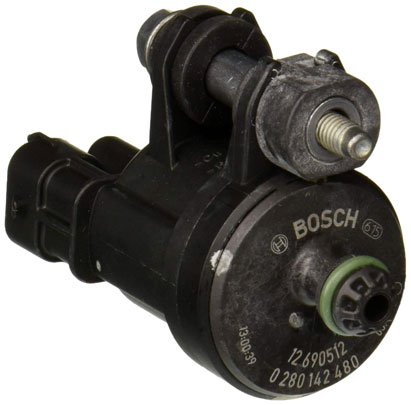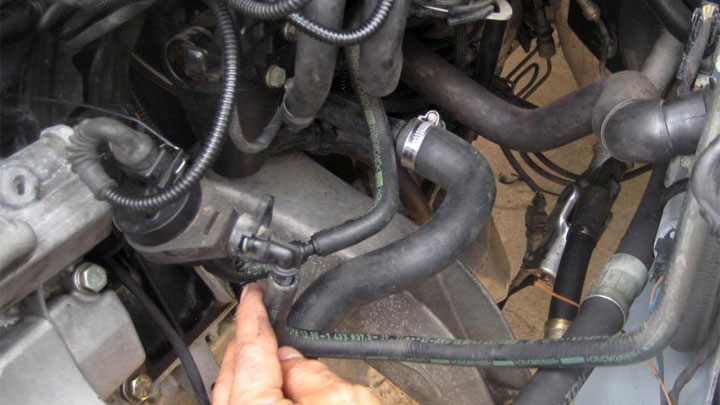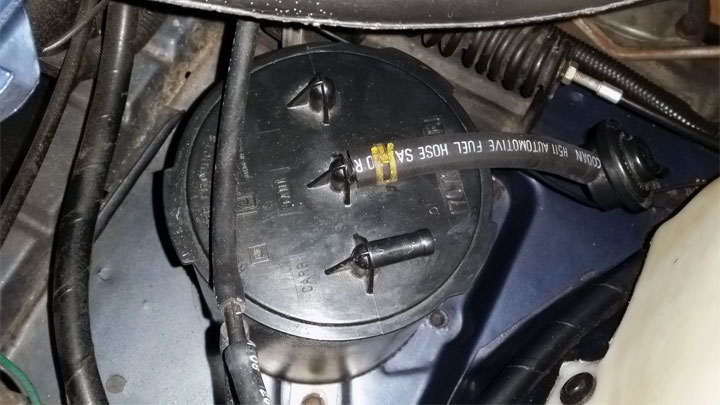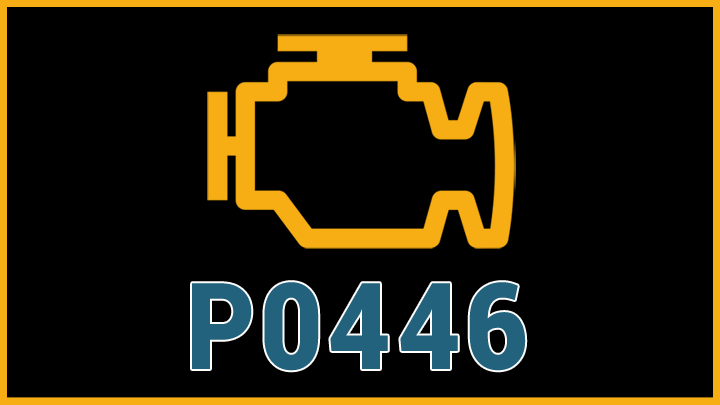Last Updated on March 31, 2022
There are over 150 chemicals in the gasoline we pump into our vehicles for fuel. When these chemicals are inhaled, a person can experience symptoms of dizziness, headaches, and difficulty breathing. If you end up inhaling the fumes of these chemicals for a long period of time, it may even kill you.
And if that’s not bad enough, air pollution and smog are caused by evaporated gas as well. That is why new legal requirements require auto manufacturers to integrate special technology into their cars which reduce gasoline vapors.
A vapor canister purge valve (aka: purge valve solenoid or EVAP purge solenoid) is an important emissions control component.
If it were to fail, excess fuel vapor and emissions would be released into the atmosphere instead of being purged back into the engine. Fortunately, there are a few symptoms you can watch for that indicate a bad purge valve solenoid.
How a Vapor Canister Purge Valve Works

The Evaporative Emission Control System (EVAP) of a car contains a purge solenoid that is normally found between the intake manifold and containment canister that stores fuel vapor; both of which are in the vacuum line.
You can operate the purge valve through the vacuum or you can do it electrically. To get those fuel vapors out of the containment canister and into the intake manifold, the purge valve has to open at the right time, which it is made to do. After the vapors enter the intake manifold, they burn up.
Most vehicles these days have a computer in their engine which controls the purge valve. This purge valve solenoid will close whenever you turn the engine off.
When you start the engine and let it run for a few minutes, the computer of the engine will electronically communicate with the purge valve and command it to open up gradually. As this happens, fuel vapor that is stored in the canister will be moved to the engine where it will burn up during the combustion process.
There are many sensors within the engine which manage the purge flow and allow the engine to determine when the purge valve should open.
If there is too much or too little purge flow under a particular condition, then the “Check Engine” light will illuminate on the vehicle’s dashboard to let you know that something is wrong.
Bad Purge Valve Solenoid Symptoms
Here are four of the most common symptoms you’ll experience if you have a faulty vapor canister purge valve.
#1 – Rough Idling

When there is a problem with the purge valve or charcoal canister, you will notice that your car is idling at a lower RPM than normal. This is called a rough idle and if low enough, it will make the car shake or even make the engine die.
If the purge valve or canister were to fail altogether and then stick out in the open, then a vacuum leak will form. This will have a grave impact on the quality and speed of the engine idle.
Also, if damage were to happen to the solenoid valve or any of its hoses connected to it, then a vacuum leak will form as well.
#2 – Hard to Start

If you have trouble starting your car, then this could be another sign that you have a bad purge valve or containment canister. Just like before, a vacuum leak may form and this will make it even more difficult to start your vehicle.
Not only that, a leaky vacuum hose won’t be able to prevent unmetered air from the outside from getting into the engine. This will ultimately cause problems with the air to fuel ratio. Then, the performance of your vehicle will be in jeopardy.
#3 – Poor Fuel Economy

Because the fuel vapors your vehicle normally uses during the combustion process are instead vented out into the atmosphere, fuel will not be used as efficiently. This will result in worse gas mileage than you are normally used to.
#4 – Check Engine Light Illuminates on Dashboard

Finally, the Check Engine light will illuminate on the dashboard if the purge valve is damaged. The engine’s computer will be able to tell when this valve is damaged because its sensors won’t be able to pick up the signal from there that it normally does.
Once that happens, the computer turns on the Check Engine light so that you will know there is a problem somewhere in the engine. Of course, there are many reasons why a Check Engine light will turn on but one possibility to this is engine code P0496.
You won’t know the true reason for it turning on until you or a mechanic scans the vehicle for any stored trouble codes. The fault code(s) will help identify what the real problem is, whether it’s purge valve related or something completely different.
See Also: Code P0441, Code P0443
Vapor Canister Purge Valve Replacement Cost
Best places to order parts? See: 19 Best Online Auto Parts Stores

Replacing a canister purge solenoid is a pretty straightforward type of job that doesn’t cost too much. Expect to pay anywhere from $80 to $200 in total.
The part will typically cost anywhere from $30 to $120, while the labor costs will be right around $50 to $80. Then, of course, there are fees and taxes added on to this price too.
Replacing the purge valve yourself is very doable so you can save a few dollars on labor.





Fixed purge valve check engine came back on p4402
Sounds like there is a leak in the evap system. They make kits that can help you detect evap leaks yourself, if that is something you are interested in.
Where to get the kit and how does it work ?
You can find them online. Just search something like “evap leak kit” or “automotive smoke tester” and see what comes up.
Basically the kit pumps smoke into the system, allowing you to clearly see any leaks in vacuum or evap lines. If you have a leak, the smoke will come out of some place where it’s not supposed to.
I wouldn’t buy one make one at home with an old soldering gun. Google how to make a home made smoke machine. It’s very easy!